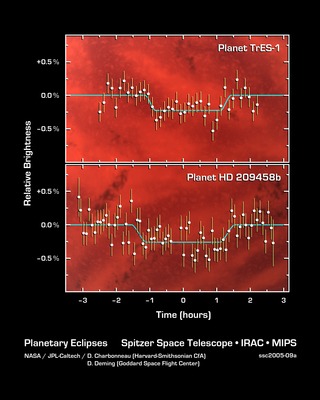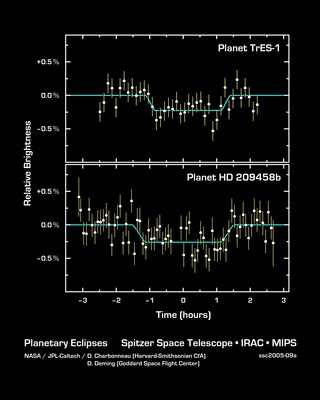
Credit: NASA/JPL-Caltech/D. Charbonneau (Harvard-Smithsonian CfA) and D. Deming (Goddard Space Flight Center)
Chart • March 22nd, 2005 • ssc2005-09a1
ssc2005-09a1
This graph of data from NASA's Spitzer Space telescope shows changes in the infrared light output of two star-planet systems (one above, one below) located hundreds of light-years away. The data were taken while the planets, called HD 209458b and TrES-1, disappeared behind their stars in what is called a "secondary eclipse." The dip seen in the center of each graph represents the time when the planets were eclipsed, and tells astronomers exactly how much light they emit.
Why a secondary eclipse? When a planet transits, or passes in front of, its star, it partially blocks the light of the star. When the planet swings around behind the star, the star completely blocks its light. This drop in total light can be measured to determine the amount of light coming from just the planet.
Why infrared? In visible light, the glare of a star overwhelms its planetary companion and the little light the planet reflects. In infrared, a star shines less brightly, and its planet gives off its own internal light, or heat radiation, making the planet easier to detect.
By observing these secondary eclipses at different infrared wavelengths, astronomers can obtain the planet's temperature, and, in the future, they may be able to pick out chemicals sprinkled throughout a planet's atmosphere. The technique also reveals whether a planet's orbit is elongated or circular.
This strategy will not work for all known extrasolar planets. It is ideally suited to study those Jupiter-sized planets previously discovered to cross, or transit, between us and the Sun-like stars they orbit, out to distances of 500 light-years. NASA's Spitzer Space Telescope was the first to successfully employ this technique.
The data of HD 209458b were taken by Spitzer's multiband imaging photometer using the 24-micron array. The data of TrES-1 were taken by Spitzer's infrared array camera using the 8-micron array.
About the Object
- Name
- HD 209458b • TrES-1
- Type
- Star > Circumstellar Material > Planetary System
- Planet > Type > Gas Giant
- Planet > Special Cases > Transiting
- Star > Type
- Distance
- 153 Light Years
Color Mapping
| Band | Wavelength | Telescope |
| Infrared | 8.0 µm | Spitzer IRAC |
| Infrared | 24.0 µm | Spitzer MIPS |
Astrometrics
- Position ()
- RA =19h 4m 9.8s
- Dec = 36° 37' 57.0"
- Field of View
- 0.0 x 0.0 arcminutes
- Orientation
- North is up





